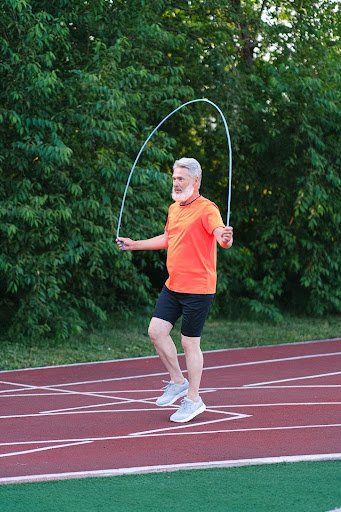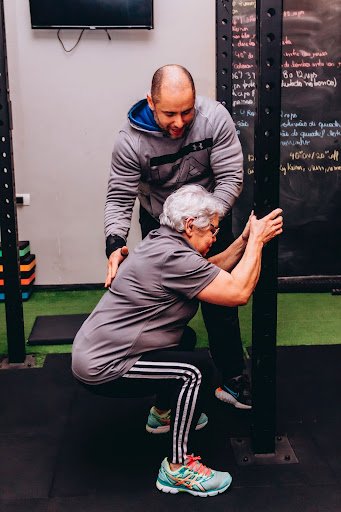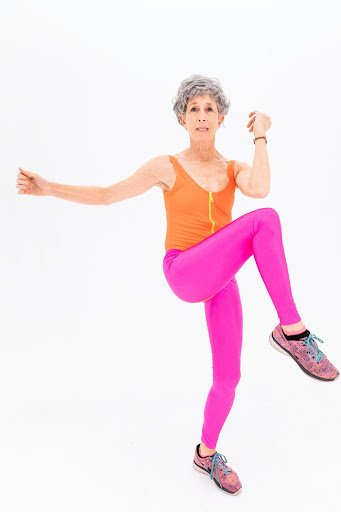Osteoporosis is a condition affecting the bones, in which the bones lose strength (technically known as lower bone density), meaning there is an increased risk of fracture. With normal ageing there is a gradual loss in bone density over time as the structure and function change. This loss of bone density or strength of bones occurs along a continuum, and there are certain risk factors related to our genetics, or sex, and our lifestyles that can speed up this continuum.
Osteopenia and osteoporosis represent certain points along this continuum of bone density loss. People with osteopenia demonstrate a lower bone density than average (it is a midway point between normal bone density and osteoporosis). Whereas people with osteoporosis have significantly lower bone density than average, and a significantly increased fracture risk.
The image below is a visual depiction of this bone loss continuum.

To learn more about the different stages of bone mass loss, read our in depth article on osteopenia vs osteoporosis here. Or save it for after this one!
In this article we hope to give you more information on the type of exercises that are recommended for osteoporosis.
The most effective exercises for osteoporosis include:
- Exercises that are weight bearing (this means using your body weight against gravity) with impact
- Muscle strengthening or resistance based exercises
These types of exercises are important both in younger age to ensure peak bone mineral density and prevent osteoporosis occurring, but equally important and effective if bone density loss has already occurred, including if there has been a diagnosis of osteoporosis. At any point in our lives bones are living tissue, and appropriately stimulating bones helps them to stay healthy.
Weight Bearing Exercise for Osteoporosis

This predominantly means exercises in standing against gravity, where your feet against the floor causes some impact. This type of impact, as long as it is pain free and built up gradually, is very good for your bones. It provides the stimulus needed to bones to stimulate bone remodelling. In this way weight bearing exercises are better than cycling or swimming in osteoporosis.
Low impact weight bearing options include: walking, brisk walking, marching, stair climbing, gentle heel drops and stamping on the ground.
Moderate weight bearing options include: jogging or running, dancing, team or racket sports, skipping, hopping, low level jumping, and more vigorous heel drops and stamping.
Higher impact weight bearing options include: basketball, volleyball, star jumps, track sports, tuck jumps and high level jumps.
These options have been taken from the Royal Osteoporosis Website.
They recommend for most people with osteoporosis, and people without osteoporosis, about 50 moderate ‘impacts’ on most days. We can take the impact options from the moderate weight bearing options. This means skipping, hopping, low level jumping or stamping 50 times.
For those with a spinal fracture, or who are not physically strong or fit enough for the moderate exercises, 20 minutes of lower impact exercise is recommended on most days. This means 20 minutes of walking, brisk walking, stair climbing, or marching.
For those who are unable due to any regular exercise due to pain, or lack of physical fitness or strength, it is recommended to start with simply avoiding sitting and trying to stand for a few minutes every hour.
These are great simple explanations of where to start for people with osteoporosis (and for all of us to keep our bones healthy).
Muscle Strengthening & Resistance Based Exercises For Osteoporosis

We have discussed numerous times the benefit of muscle strengthening or resistance based exercises. One of the benefits is for bone density or bone strength. This is because as our muscles work, they pull on the bones, which also stimulates the bones, causing them to respond, remodel and become stronger.
We have lots of different articles on muscle strengthening for you to explore across this website. The best place to start is our Beginners Guide to Strength Training for Older Adults.
Essentially for muscle strengthening exercises we have to be asking our muscles to work against a form of external load or resistance: this can be your body weight, or as we get stronger we can add in extra load/resistance, including household items, bands, weights etc.
As our muscles get stronger, it is important to gradually increase the intensity of the exercises by increasing the resistance or the weights. This ensures the exercises are still challenging enough to be effectively stimulating the muscles and the bones. We also need to be performing them regularly enough, with enough rest period in between, to most appropriately work the muscles. It is generally recommended to perform muscle strengthening exercises 2-3 days a week, with rest days in between (to allow the muscles to recover).
In terms of how many repetitions or sets to be performing in each session, you want to be aiming for roughly between 8-12 repetitions x3 sets for each exercise. The weight or resistance needs to be challenging enough that you feel you couldn’t do many more repetitions each time (otherwise it means the exercise is too easy and you probably need to progress it, or add weight to ensure it is effective).
To explore this further, check out these free resources below:
- The Best Resistance Training Exercises for Older Adults
- Beginners 6 Week Strength Training Programme For Older Adults
- The Royal Osteoporosis Society: Exercise and physical activity for osteoporosis and bone health
What About Balance Exercises?

Balance exercises are recommended 2-3 times a week for all older adults, and even more so in those with osteoporosis. This is because with lower bone density there is an increased risk of fracture with a fall. We need to have a good balance system to reduce our risk of falling. Our balance system is made up of different components: our vision, our vestibular system and proprioception from our joints, ligaments and tissues.
Balance is a skill that needs to be practiced often, that is why it is recommended to practice a few times a week; although every day is better if you can! The type of balance exercise that is appropriate for you depends on your current ability. It needs to be challenging in order to be stimulating your balance system enough.
There are some great example of balance exercises on the Royal Osteoporosis Website: https://theros.org.uk/information-and-support/osteoporosis/living-with-osteoporosis/exercise-and-physical-activity-for-osteoporosis/staying-steady/
Additionally, some forms of exercise also include a large balance component: for example Tai Chi, Yoga or Pilates are some great options!
Recommended reading: The Benefits of Yoga and Pilates for Older Adults
Is high intensity exercise safe with osteoporosis?
Healthcare professions were traditionally more hesitant about prescribing higher intensity exercise for those with osteoporosis. However fortunately more research is coming out, showing it is not only safe, but also effective in increasing bone density.
We did discuss the LIFTMOR Trial in our previous article exploring the difference between osteopenia and osteoporosis, however it is such a great trial we will discuss it again! The LIFTMOR Trial was published in 2019. The study included 101 postmenopausal women with osteopenia or osteoporosis. They were randomised to different exercise programmes over an 8 month period. One group participated in a high intensity regime of 5 sets of 5 repetitions of exercises such as squats, deadlifts and overhead shoulder press, as well as jump chin ups with drop landings. The weights were kept high throughout (i.e. 80-85% of their 1 repetition maximum). This group was compared to a low intensity home based programme of walking, stretching, lunges, calf raises and some upper body exercises.
At 8 months the women in the higher intensity group showed significant increases in the bone mineral density of the lumbar spine and femoral neck, as well as increased strength and functional measures on performance testing. Importantly, no fractures or adverse events were reported throughout the trial.
This type of trial is very reassuring that we can safely prescribe higher intensity and loaded exercises to people with osteopenia or osteoporosis. However this trial was done under supervision, and the authors have stated that currently this protocol cannot be recommended in unsupervised environments. Perhaps more research is needed into higher intensity unsupervised resistance programmes?
Check out the full details of the LIFTMOR trial: https://pubmed.ncbi.nlm.nih.gov/28975661/
Where can I find more information specific to osteoporosis?
The Royal Osteoporosis Society has lots of fantastic information on managing osteoporosis. The fact sheets, booklets and information films section is especially useful if you have more specific questions.
They also have a free helpline number to call to speak to a specialist nurse for more support.
In Summary
Weight bearing exercises and muscle strengthening exercises are ESSENTIAL in those with osteoporosis, osteopenia, or those with health bone density who are looking to preserve or improve it. Our bones are living cells which require stimulation for appropriate remodelling and strengthening. The level of weight bearing impact exercises and muscle strengthening exercises that you start with depends on your current levels of physical activity or fitness. These can be scaled appropriately. It is important over time we gradually try to progress these to ensure they remain challenging.
Ultimately even with a diagnosis of osteoporosis, there remains a lot of hope that we can improve our bone density.





